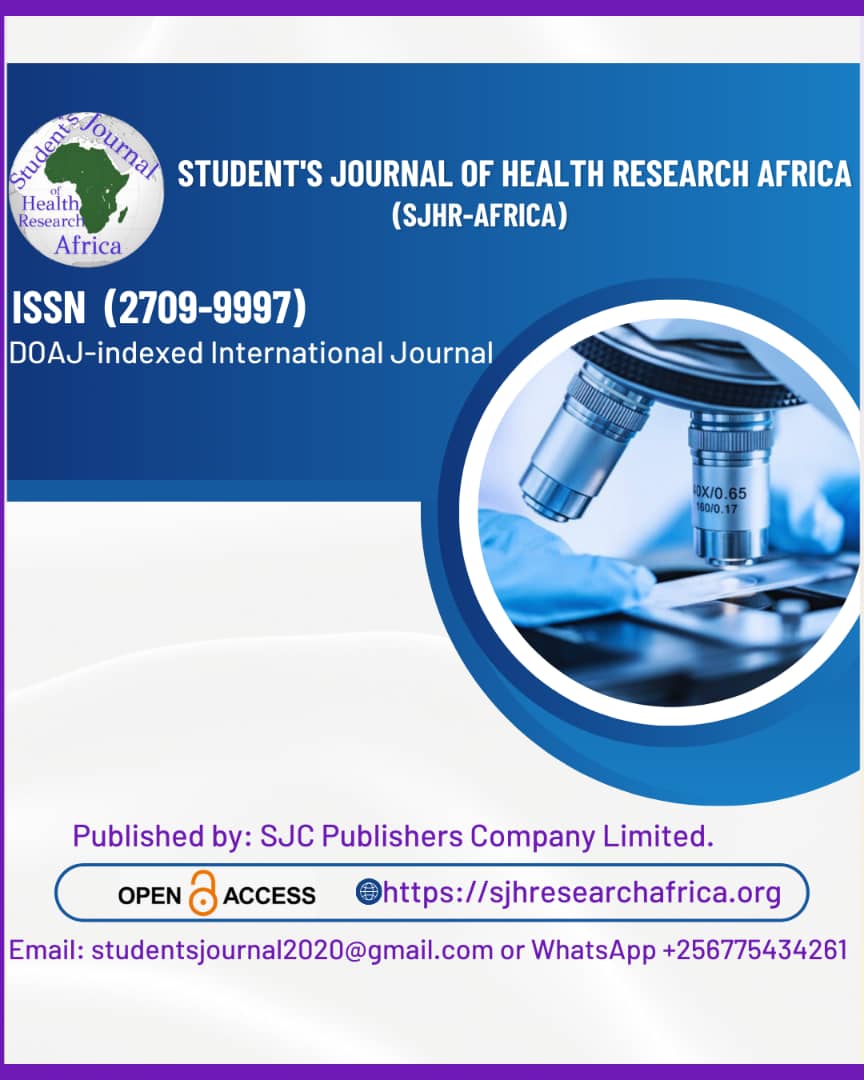A PROSPECTIVE STUDY OF FUNCTIONAL OUTCOME OF HOFFA FRACTURE TREATED WITH CANNULATED CANCELLOUS SCREWS, HERBERT SCREWS AND BUTTRESS PLATES – A PROSPECTIVE OBSERVATIONAL COHORT STUDY.
DOI:
https://doi.org/10.51168/sjhrafrica.v6i3.1663Keywords:
Neers score, articular anatomy, lag screw, cannulated cancellous screw, Hoffa's fractureAbstract
Background
The three categories of partial articular fractures that make up distal femur AO type 33 B fractures are coronal split fracture, medial condyle fracture, and sagittal lateral condyle fracture. The rate of damage or the degree of osteoporosis influences the likelihood of a distal femur fracture.
Objectives
Examining the functional results of Hoffa fractures—coronal plane fractures of the femoral condyle—treated with buttress plates, cannulated cancellous screws, and Herbert screws is the goal of this study.
Materials and Methods
The orthopedic department of Srirama Chandra Bhanja (SCB) Medical College in Cuttack, Odisha, India, carried out this prospective study to examine the functional results of Hoffa fractures treated with buttress plates, cannulated cancellous screws, and Herbert screws. The research was conducted from June 2022 to May 2024.
Results
The study included 20 patients with an average age of 30.25 ± 7.01 years, predominantly male and manual laborers. Right-sided Hoffa fractures were more common, with Type I fractures and lateral condylar involvement being the most frequent. Male competitors made up 14 (70%), while female participants made up 06 (30%). 4.15±1.66 days passed between the injury and operation. The mean radiological union time was 2.3 ± 1.49 months, and the mean functional Knee Society Score was 80.45 ± 15.01. Complications were minimal, with infection in 10% and delayed union in 5% of cases.
Conclusion
Hoffa fractures are most frequently observed in male young adults and are mostly caused by automobile accidents. According to the results, anatomical factors also suggest that the lateral condyle sustains injuries more frequently than the medial condyle. Interestingly, every instance in this study was identified by X-ray and verified by CT scans, indicating that careful monitoring of X-rays by themselves can successfully detect Hoffa fractures.
Recommendation
Early intervention and tailored surgical approaches may improve Hoffa fracture outcomes.
References
Jain S. Distal Femur AO type 33 B-surgical options, results, and complications (including Hoffa's fracture). Trauma International. 2016;2:20-3. https://doi.org/10.13107/ti.2016.v02i01.015
Holmes SM, Bomback D, Baumgaertner MR. Coronal fractures of the femoral condyle: a brief report of five cases. Journal of Orthopedic Trauma. 2004 May 1;18(5):316-9. https://doi.org/10.1097/00005131-200405000-00010
PA O. Long-Term Results of Unicondylar Fractures of the Femur. J. Orthop. Trauma. 1994;8(32):142-6. https://doi.org/10.1097/00005131-199404000-00011
Müller ME, Allgöwer M, Schneider R, Willenegger H, Tscherne H. Femoral Shaft and Distal Femur. Manual of INTERNAL FIXATION: Techniques Recommended by the AO-ASIF Group. 1991:535-52. https://doi.org/10.1007/978-3-662-02695-3_12
Shelbourne KD, Brueckmann FR. Rush-pin fixation of supracondylar and intercondylar fractures of the femur. JBJS. 1982 Feb 1;64(2):161-9. https://doi.org/10.2106/00004623-198264020-00002
Siliski JM, Mahring MA, Hofer HP. Supracondylar-intercondylar fractures of the femur. Treatment by internal fixation. JBJS. 1989 Jan 1;71(1):95-104. https://doi.org/10.2106/00004623-198971010-00015
CHARLES S NEER II, Grantham SA, SHELTON ML. Supracondylar fracture of the adult femur: a study of one hundred and ten cases. JBJS. 1967 Jun 1;49(4):591-613. https://doi.org/10.2106/00004623-196749040-00001
Mooney V, NICKEL VL, HARVEY JR JP, Snelson R. Cast-brace treatment for fractures of the distal part of the femur: A prospective controlled study of one hundred and fifty patients. JBJS. 1970 Dec 1;52(8):1563-78. https://doi.org/10.2106/00004623-197052080-00004
Sun H, He QF, Huang YG, Pan JF, Luo CF, Chai YM. Plate fixation for Letenneur type I Hoffa fracture: a biomechanical study. Injury. 2017 Jul 1;48(7):1492-8. https://doi.org/10.1016/j.injury.2017.03.044
Trikha V, Das S, Gaba S, Agrawal P. Analysis of functional outcome of Hoffa fractures: a retrospective review of 32 patients. Journal of Orthopaedic Surgery. 2017 Jul 3;25(2):2309499017718928. https://doi.org/10.1177/2309499017718928
Kurahatti A, Seenappa H, Shanthappa AH. The functional and radiological outcome of Hoffa's fracture was treated with cannulated cancellous screws. Cureus. 2022 Apr 4;14(4). https://doi.org/10.7759/cureus.23829
Nedunkilli V. A Prospective study of Functional Outcome of Coronal Plane Fracture of Femoral Condyle treated with Cannulated Cancellous Screws (Doctoral dissertation, Stanley Medical College, Chennai).
Manfredi M, Gildone A, Ferrante R, Bernasconi S, Massari L. Unicondylar femoral fractures: therapeutic strategy and long-term results. A review of 23 patients. Acta Orthopaedica Belgica. 2001 Apr 1;67(2):132-8.
Singh R, Singh RB, Mahendra M. Functional outcome of isolated Hoffa fractures treated with cannulated cancellous screw. Malaysian Orthopaedic Journal. 2017 Jul;11(2):20. https://doi.org/10.5704/MOJ.1707.016
Downloads
Published
How to Cite
Issue
Section
License
Copyright (c) 2025 Sarthak Sahoo, Manmatha Nayak, Radhakishan Sahoo

This work is licensed under a Creative Commons Attribution-NonCommercial-NoDerivatives 4.0 International License.






















